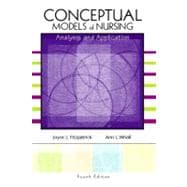
Note: Supplemental materials are not guaranteed with Rental or Used book purchases.
Purchase Benefits
| Preface | p. vii |
| Contributors | p. ix |
| Reviewers | p. xi |
| Nursing Knowledge Development: Relationship to Science and Professional Practice | p. 1 |
| The Structure of Nursing Knowledge: Analysis and Evaluation of Practice, Middle Range, and Grand Theory | p. 5 |
| Florence Nightingale: Pioneer in Nursing Knowledge Development | p. 21 |
| Peplau's Theory of Interpersonal Relations | p. 46 |
| Henderson's Conceptualization of Nursing | p. 68 |
| Johnson's Behavioral System Model | p. 83 |
| Orem's Model of Self-Care | p. 104 |
| Roy's Adaptation Model | p. 146 |
| Leininger's Transcultural Nursing | p. 177 |
| Neuman's Systems Model | p. 194 |
| King's Conceptual System and Theory of Goal Attainment | p. 225 |
| Martha Rogers' Model: Science of Unitary Beings | p. 247 |
| Newman's Theory of Health | p. 273 |
| Watson's Model of Caring | p. 297 |
| Fitzpatrick's Life Perspective Rhythm Model | p. 325 |
| Index | p. 348 |
| Table of Contents provided by Rittenhouse. All Rights Reserved. |
The New copy of this book will include any supplemental materials advertised. Please check the title of the book to determine if it should include any access cards, study guides, lab manuals, CDs, etc.
The Used, Rental and eBook copies of this book are not guaranteed to include any supplemental materials. Typically, only the book itself is included. This is true even if the title states it includes any access cards, study guides, lab manuals, CDs, etc.